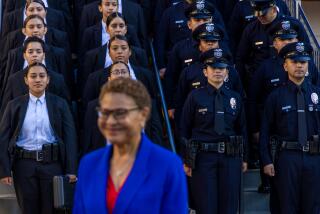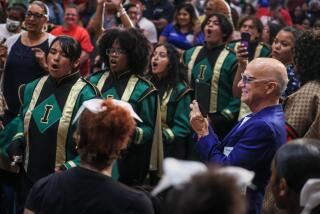Proposed L.A. Magnet High School Would Be ‘Junior Police Academy’ : Education: Riordan, other leaders say the plan would improve the quality of law enforcement recruits. But funding appears to be a major hurdle.
- Share via
In an effort to improve the quality of police recruits in Los Angeles, city and school officials announced Wednesday a proposal to open what may be the nation’s first magnet school offering law enforcement classes to high school students.
Mayor Richard Riordan, Councilwoman Laura Chick and former school board President Roberta Weintraub have teamed up to push the idea of a “Junior Police Academy” at a time when Riordan is struggling to increase police deployment in the face of a devastating attrition rate and when the department’s racial attitudes are under scrutiny.
“There has been a lot of talk about how to find police candidates that reflect the neighborhoods of the city,” said Chick, a west San Fernando Valley lawmaker who introduced the proposal Wednesday. “This will allow us to do that.”
Her motion requests city and police staff to report to the council’s Public Safety Committee in two weeks on the feasibility of the proposal and possible funding sources.
Initially, the magnet would begin in the fall of next year and would be an offspring of the law and government magnets at Dorsey High School in the Crenshaw area, Monroe High School in the San Fernando Valley and Wilson High School in El Sereno.
In addition to traditional high school courses, the curriculum would include courses on the judicial system, history, practices of law enforcement, Spanish, computers, report writing, physical training and diversity training.
Supporters said they eventually will request school funding for a full-fledged magnet with up to 200 students drawn from every school in the district.
“If you are getting kids out of East Los Angeles, South-Central and the Valley, we would hope this will encourage them to stay in this community,” said Weintraub, who originally proposed the idea months ago during her unsuccessful bid for a City Council seat.
Although the idea has been praised by various police, school and city leaders, funding appears to be a major hurdle.
The city’s proposal offers $150,750 to help the school district pay for a director, a program development analyst, and clerical and legal support. But supporters could not provide a bottom line for other costs, such as teacher salaries, transportation and textbooks.
Mark Slavkin, president of the Los Angeles Unified School District board, said the proposal is interesting. But he added that the district is considering several other ideas for new magnets and does not have the money to fund all the schools.
Magnets were designed to integrate students who are interested in advanced classes in medicine, science, music and other fields. The district now operates 124 magnet programs.
Slavkin said the biggest expense of magnet programs is transporting students from other schools to classes--about $1,400 per student per year.
“Is it the best use of our limited resources or should we spend money on a new math, science or music magnet that other parents are asking for?” he said.
Police Chief Willie L. Williams has similar concerns. He supports the concept but has not formally approved the LAPD’s participation until he is certain that it will not drain the force’s limited resources, Deputy Chief David Gascon said.
Under Riordan’s public safety plan, the department is slated to hire 1,040 new officers by June. But Gascon said the Police Academy’s testing and screening process eliminates nearly 19 of every 20 applicants. To hire the 1,040 new officers, he said the department would have to have more than 20,000 applicants.
Gascon said a police magnet may improve that ratio by preparing potential recruits for the academy’s testing and screening process.
“Our interest is that we make sure the students in the magnet schools receive all the core classes that are essential to law enforcement,” he said.
Supporters say they understand that school funding is limited and are hoping to help defray the costs by forming a nonprofit organization to accept state and federal grants and contributions from individuals and foundations.
“My hope is that we would build on our track record of creating public and private partnerships,” Riordan said. “By tapping private funding sources, the impact of the city budget would be minimized and the involvement by the community would be maximized.”
Weintraub, who drafted an extensive report on the proposal, sees another benefit of the program. She said students who are accepted into the magnet will be motivated to stay out of trouble in high school, knowing that they will not be accepted into the academy unless they have no criminal record.
“This is going to be an idea whose time has come,” she said.
More to Read
Sign up for Essential California
The most important California stories and recommendations in your inbox every morning.
You may occasionally receive promotional content from the Los Angeles Times.











